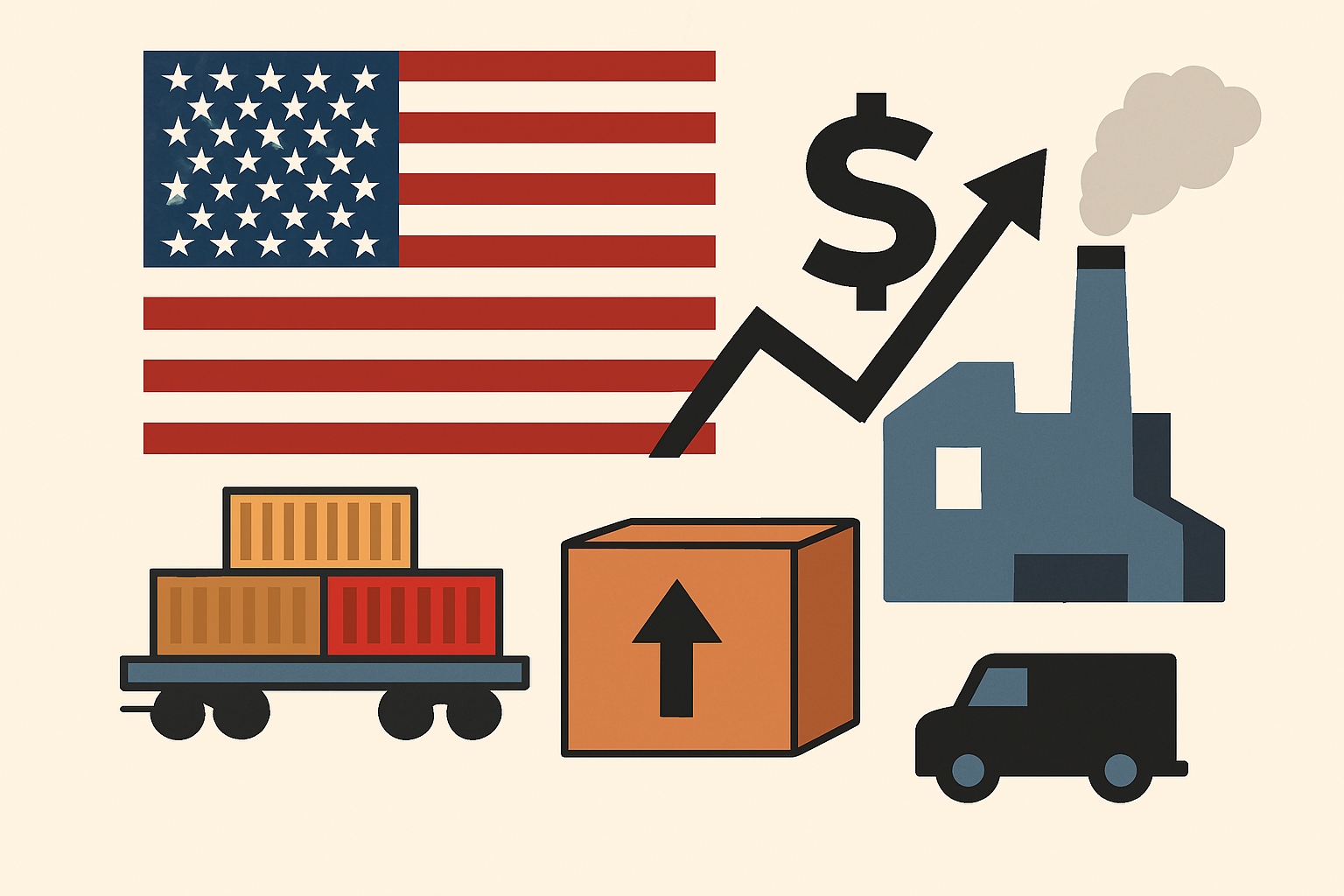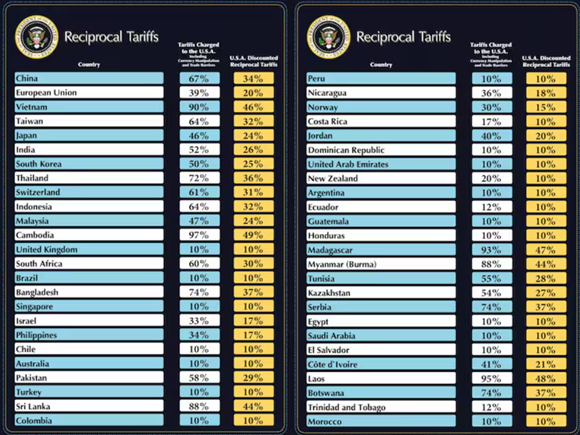Trump's New Tariff Strategy: A Bold Move to Rebuild U.S. Manufacturing
Published Date: 03 Apr 2025
In an unexpected strategic move, former President Donald Trump is introducing new tariffs that would restructure the trade situation globally and boost American manufacturing. It has become necessary to raise one's voice to protect the domestic economy and to keep the U.S. competitive on the world stage. New tariffs announce themselves as retaliation for high trade barriers against other nations so that the U.S. gets a fair deal in trade arrangements.

The economic policies of Trump during his presidency were mostly characterized by a very robust "America First" stance that was to lead to the reduction of U.S. trade deficits, bringing back the jobs for manufacturing to the U.S., and attaining a more favorable balance of trade. His last attempt to impose tariffs was met with equal outrage, mostly by global partners. This latest initiative would implement a stronger and more aggressive reciprocal approach to international trade.
The Economic Rationale Behind the Tariffs
Under the pretense of tariffs, two arguments are put forth. Protecting homegrown industries is the first justification, and creating a more advantageous trade pact is the second. The goal of this new tax is to encourage corporations that have relocated numerous manufacturing jobs abroad due to globalization to bring those jobs back to the United States. Because domestically manufactured items are now competitively priced due to higher levies on imports, consumers are encouraged to choose imports.
A balanced trade environment is probably what the tariffs will produce. The majority of American businesses have been protesting about unfair trade practices in nations like China, India, and the European Union for a long time, notably in the manufacturing and clinging agriculture sectors. It was discovered that these nations had extremely high tariffs and other restrictions that prevented American companies from competing in international markets. Trump's new tariff approach was causing these penalties to catch up, which would force these countries to lower their tariffs or face similar retaliatory effects of making their exports less appealing in the American market.
The ultimate objective is to achieve both objectives, namely global trading system justice and U.S. nativism. For far too long, the government has maintained that certain nations with strict protectionist laws have "rigged" commerce in all regions of the world. Therefore, these new tariffs aim to impose regulations on everyone without the same drawbacks.
The Core of Trump's Tariff Proposal
Trump's new tariffs are supposed to be a part of a bigger scheme that would successively tackle trade imbalances that have caused stress between the U.S. and its major partners. The United States' tariffs on high-trade-barrier nations that impose taxes on American imports are a reciprocal method of increasing the barrier to enable competition, which will force other nations to reduce theirs or, in the fullest sense, benefit American manufacturers and producers.

Reciprocity is to be one of the major aspects of this policy. As he puts it, "the U.S. bears damage from countries having high tariffs or non-tariff barriers resulting from American goods-favored trade terms." For instance, given that taxes beset countries set high tariffs as a general practice, it sends a very "deep message" that access into the American market implies playing by agreed rules.
Such new initiatives bashed away from the previous administration's approach, in which more focus was laid on dealing with trade agreements such as that of the United States-Mexico-Canada Agreement (USMCA) than on putting tariffs as instruments of economic leverage. Under the Trump plan, tariffs would again find fresh strength as instruments of protection for U.S. businesses, especially manufacturing, which has felt a slow decline over the last decades due to globalization and outsourcing.
Potential Benefits of the Tariffs
Trump's new tariffs have one potential positive impact on America and the revival of American manufacturing. American businesses would be able to become more competitive if tariffs were imposed on nations whose exports to the United States are made at low prices due to unfair trade practices. In sectors like steel, aluminum, and automobile manufacturing, which are anticipated to face reduced competition from low-cost imports, this could result in the creation of more jobs.
These tariffs may incentivize businesses to set up manufacturing plants in the United States in order to restore jobs in American towns, given the collapse of local production. Because the tariffs make it more expensive to import items, businesses would be forced to purchase raw materials and produce completed goods domestically, which would lead to a revival of American manufacturing.
The reciprocity tariff approach may result in advantageous trade agreements for the United States. This argument states that nations with higher tariffs will be compelled to meet and discuss more equitable trade practices if the United States imposes a charge on them. By negotiating better terms for US companies in international markets, value tariffs may be lowered. Countries that have historically imposed high tariffs on US exports, like China and India, might be prepared to make compromises to keep access to the lucrative American market.
The Risks and Challenges
While there are undoubtedly significant benefits that could result from Trump's tariff plan, supporting such a bold endeavor has equally significant risks. The threat of a trade war is arguably the most significant of these. This might escalate into a bigger conflict impacting industries on both sides if other nations respond by imposing tariffs on American goods. For instance, nations that rely significantly on exports to the United States may impose tariffs in retaliation on American agricultural goods, like corn, soybeans, and pork, which would significantly impact American farmers.
Rising consumer costs pose a further threat. Imports may become more costly as a result of increased tariffs, and American consumers may also have to pay more for commonplace items like apparel and gadgets. Low-income families might be harmed by such price increases since they might not be able to adapt to price flexibility.
The other nations' readiness to engage in negotiations or their desire to remain firm and engage in a tit-for-tat tariff battle will determine how well Trump's tariff approach works. The reciprocal method can just lead to more ambiguity, and there is no assurance that it would yield the desired outcomes.
The Geopolitical Implications
Trump’s tariff proposal also carries significant geopolitical implications. The emerging tariffs put the U.S., which had for the longest time been the dominant country in the global trade system, at a possible risk of redefining the patterns of strength and cooperation within international trade. China and the European Union may start seeking to enter into new trade relationships with other countries as a buffer against the U.S.'s economic power, which in turn could lead to a major recomposition of global trade partnerships. The U.S. might come under fire from international organizations like the WTO. If tariffs are viewed as violating international trade regulations, the United States may eventually face legal action and sanctions.
Impact on the Automobile Sector: A Shift in the Industry’s Dynamics
Trump's tariff plan has a significant impact on the automobile sector, especially in the case of U.S. automobile manufacturing and marketing.
- Higher Costs for Imported Parts
Tesla and other automakers import various components, such as batteries, steel, and electronics. These parts will unavoidably become more expensive as import duties rise, raising the cost of production. Should the additional expenses be paid by the business, Tesla's vehicle pricing may be impacted by the higher production costs, which might slow down demand or lower earnings.
- Opportunities for U.S. Manufacturers
The tariffs might increase the competitiveness of American automobiles. Imposing tariffs will raise the price of imported automobiles, which will boost demand for goods made by US firms like Ford and GM. It might even force companies like Tesla to stop depending on foreign supply chains and begin manufacturing more automobiles in the United States, which would ultimately result in lower prices.
- Increased Competition in the EV Market
Increased competition for Tesla will come from the more focused on electric vehicles carried out by other automakers. Tariffs will increase the cost of imported vehicles, and the traditional brands are expected to push for more presence in the electric vehicle space within the U.S., creating further pressure in the EV market. This will trigger innovation while also posing challenges to Tesla in retaining its leadership.
Conclusion
Trump's tariff policy aims to boost American manufacturing by resolving trade imbalances and protecting American sectors from unfair foreign competition. While this approach might induce firms to bring jobs back to the U.S., there are considerable risks attached, including possible trade wars and increased prices for consumers. The tariff proposal could bring about preferable trading conditions if there were another willing to negotiate, but conversely, it could bear heavily on global trade relations. The tariffs may spur innovation in industries like autos, but they may also make electric vehicles more competitive. The success or integrity of this approach ultimately depends on how other countries respond to it and whether the United States can fulfill its economic demands without seriously upsetting anyone else in the world.
Maximize your value and knowledge with our 5 Reports-in-1 Bundle - over 40% off!
Our analysts are ready to help you immediately.
